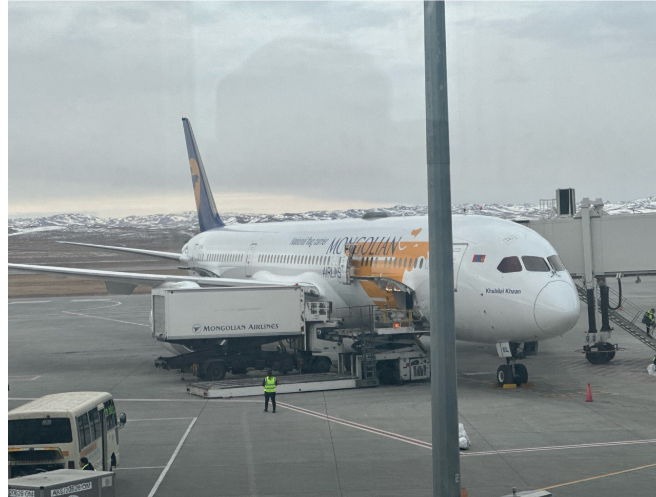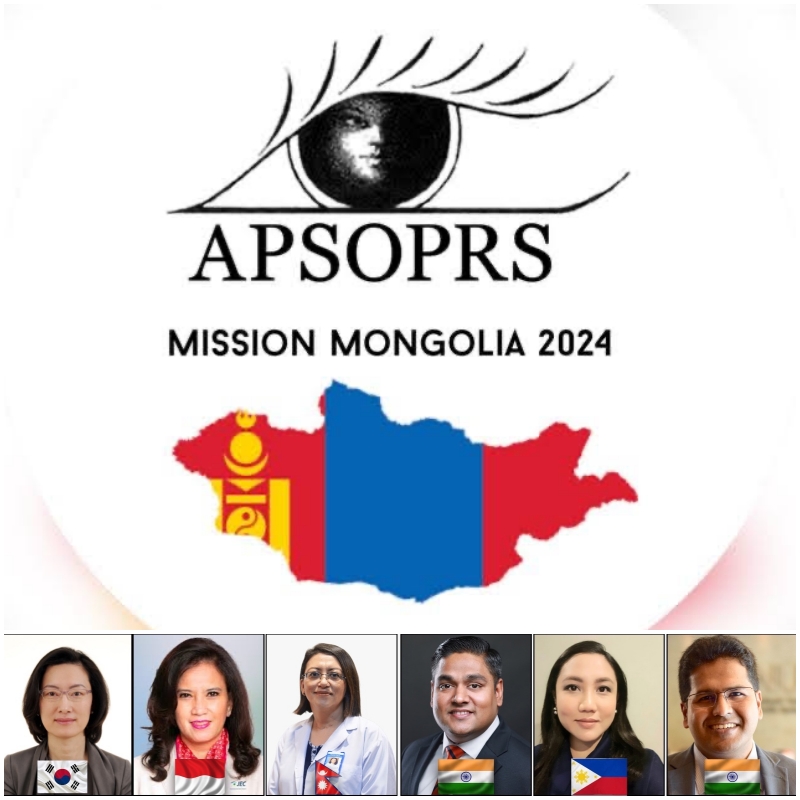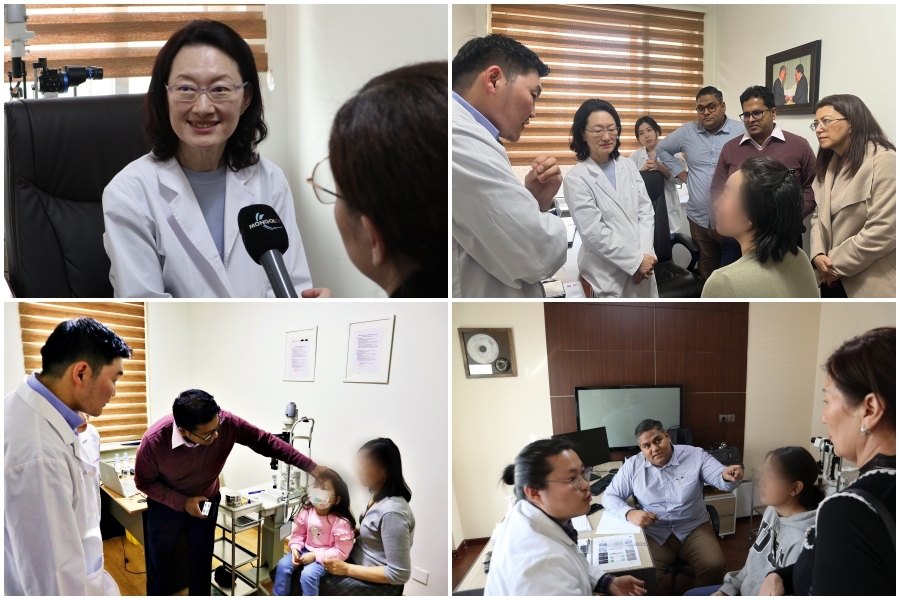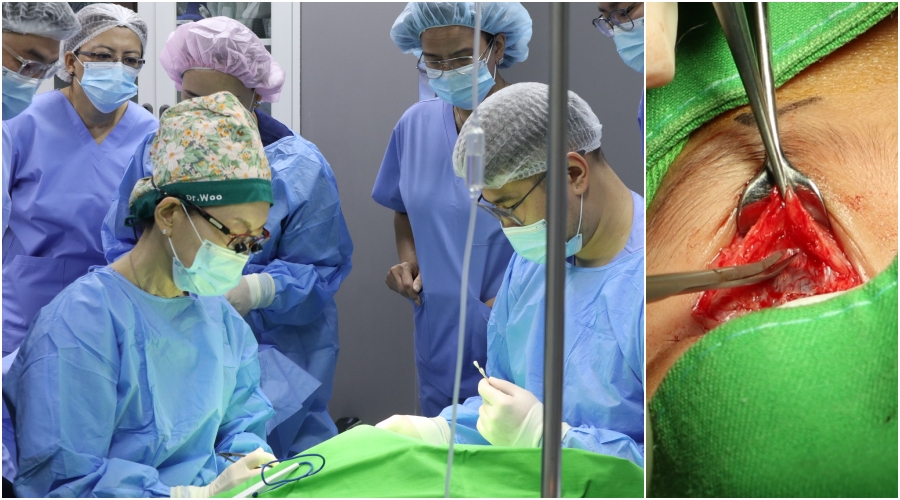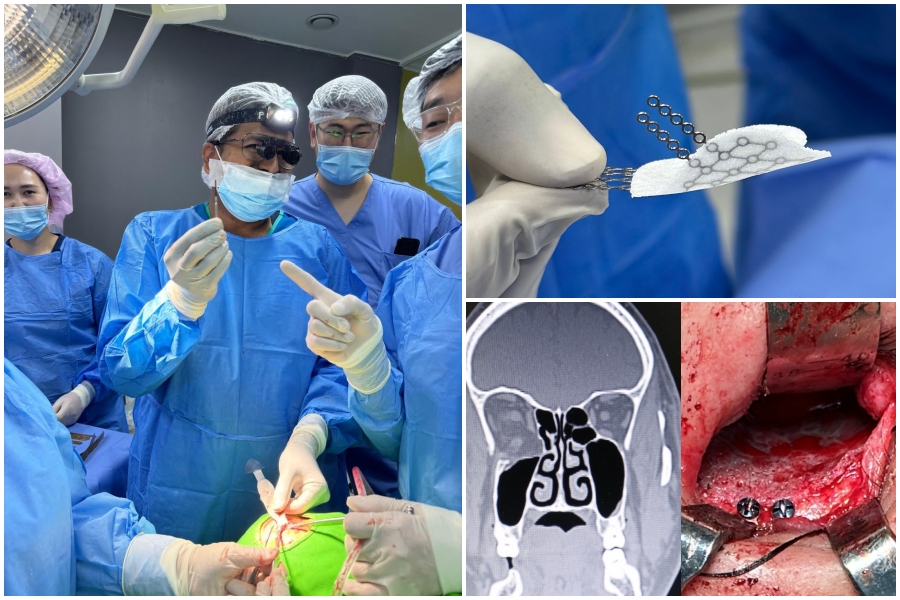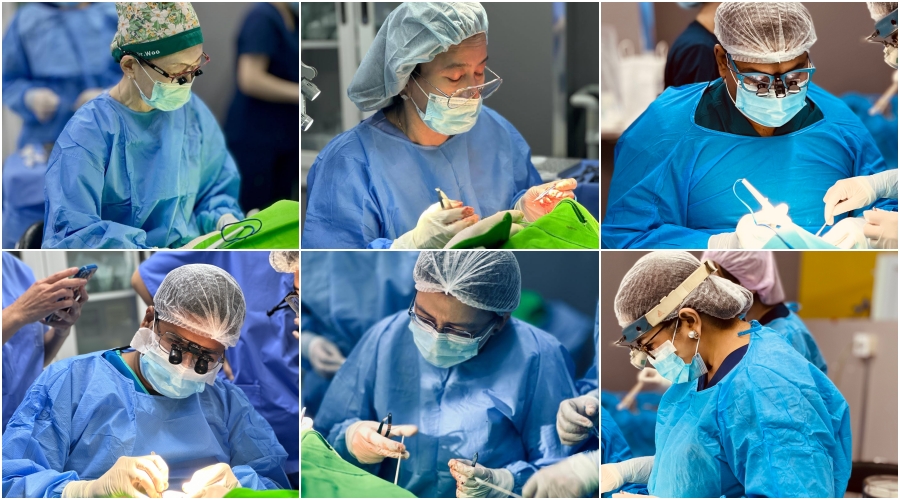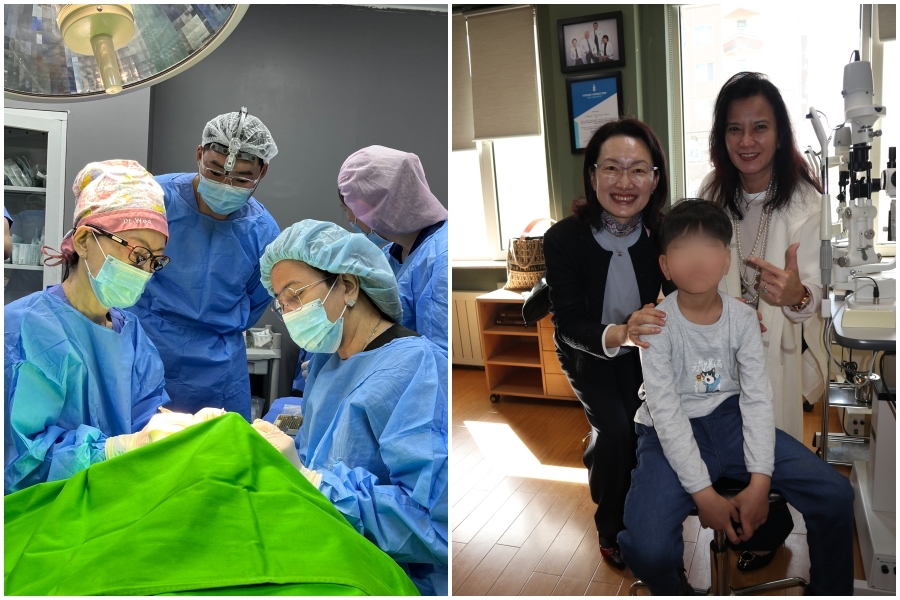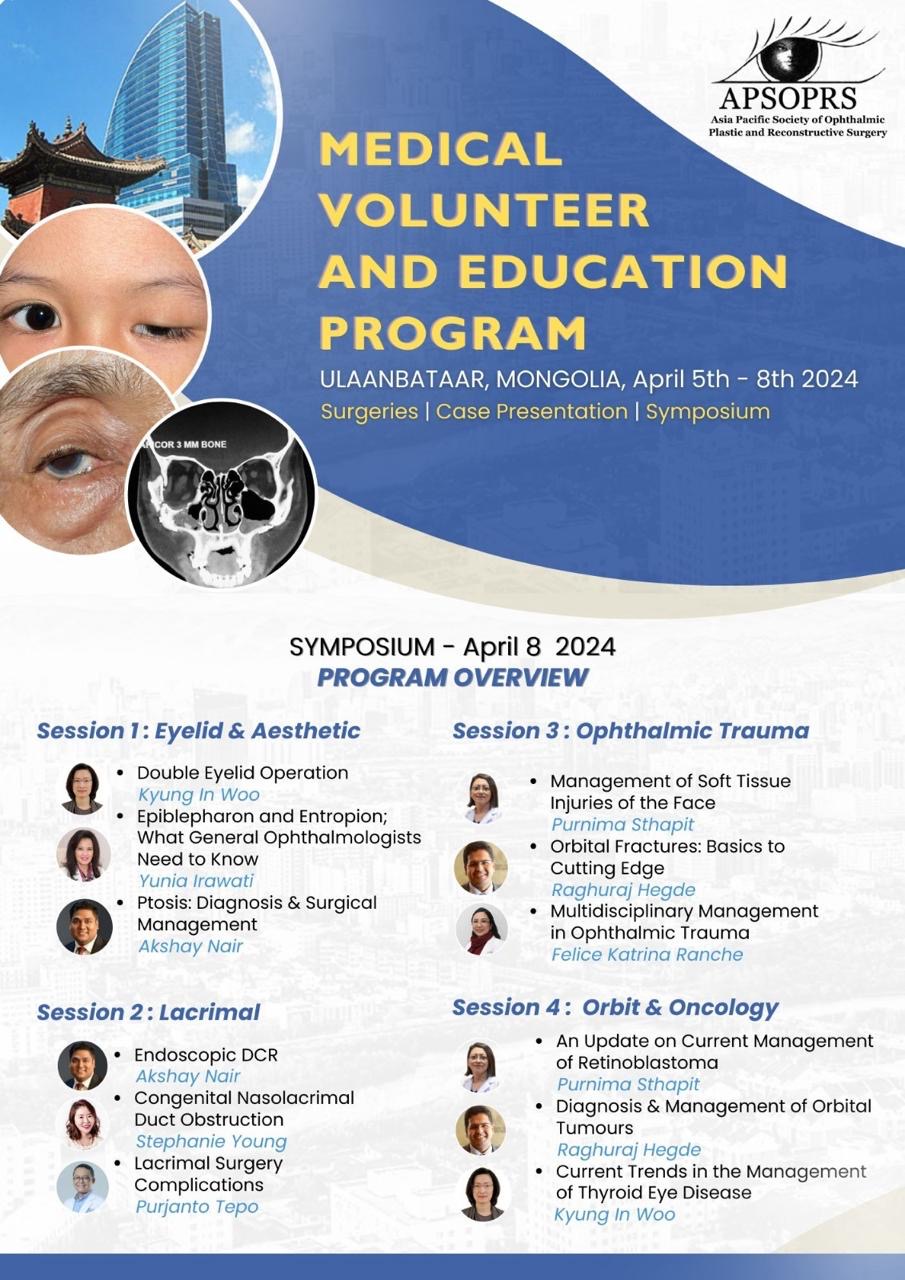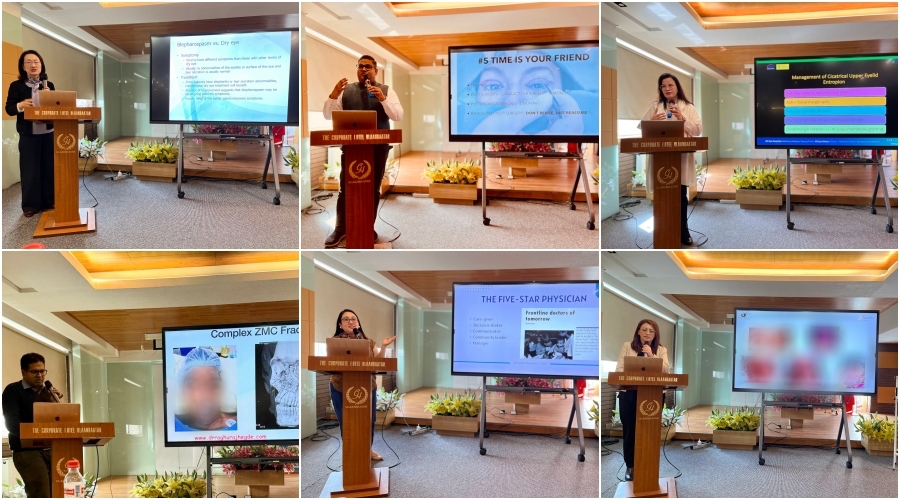The APSOPRS Surgical & Teaching Mission Trip to Mongolia
Dr. Raghuraj Hegde Head & Sr. Consultant, Orbit, Ophthalmic Plastic Surgery & Oncology Service, Department of Ophthalmology, Manipal Hospitals, Bangalore. Adjunct Faculty, Orbit, Ophthalmic Plastic Surgery & Oncology Service, Department of Ophthalmology, Kempegowda Institute of Medical Sciences, Bangalore
Wall Art on Seoul Street in Ulaanbaatar
Introduction One of the first sights of Mongolia for us was the permafrost covered mountains as our plane was landing at Chinggis Khan International Airport, Ulaanbaatar. It was supposed to be spring but when we got out of the airport, it felt windy and cold- a lot like winter. It was -1C the day we landed. I hear that Ulaanbaatar is the coldest capital city in the world where temperatures can to -40C at the peak of winter. We were graciously received at the airport by our host hospital- Orbita Eye Hospital represented by Dr. Ari Aruinbold- their in-house oculoplastic surgeon. We had arrived in Mongolia as a part of the APSOPRS Volunteer team for a surgical & teaching mission trip.
Background
One of the first things on the agenda items during the first meeting of the new executive council of Asia Pacific Society of Ophthalmic Plastic & Reconstructive Surgeons (APSOPRS) was medical volunteering. This project was close to the hearts of the society president, Prof. Kyung In Woo and Vice-President Prof. Yunia Irawati. A medical volunteering task force was formed and the place of our first mission trip was going to be Ulaanbaatar, Mongolia. This was the first time APSOPRS was doing a mission trip.
After several zoom meetings for costing & logistics discussions along with case discussions about the cases we were to operate on- we finalized the team that was going to Ulaanbaatar. So, six surgeons from 5 countries- Prof. Kyung In Woo (Korea), Prof. Yunia Irawati (Indonesia), Dr. Akshay Nair (India), Dr. Purnima Sthapit (Nepal), Dr. Felice Katrina Trio-Ranche (Philippines) and myself- Dr. Raghuraj Hegde (India)- ended up forming the volunteering team for this mission trip. Dr. Ari Aruinbold from Orbita Eye Hospital was our point of contact at Mongolia- who would help us with temporary medical licenses and paperwork with regard to visa.
About Mongolia & Eyecare
The main motivation for this project was to provide Oculoplastic surgery expertise to under-served areas in the Asia Pacific region. The countries from where the APSOPRS members hail from are as diverse as the distances involved in traversing the Asia-pacific region. In Mongolia they have a lot of general ophthalmologists but are lacking in doctors with sub-specialty expertise. As per our hosts, Mongolia has a total of 5 oculoplastic surgeons for the whole country.
Since the fall and break-up of the Soviet Union, Mongolia’s healthcare has emerged as a free-market healthcare model. It has been struggling to transition from a state-run public healthcare to free market private healthcare enterprise. They have very eager doctors but have been lacking in training & mentorship. The present generation of ophthalmologists are breaking the mould. They have been travelling to other countries to gain expertise and returning to their home country to provide service. They have a genuine thirst for international interaction and collaboration. Mongolia is a very large country with a small population. Mongolia is a country with a population of only 3.4 million. Hence this country is sparsely populated and nearly 90-95% (as per various estimates) live in the single city of Ulaanbaatar and surrounding region.
The Mission Trip The decided schedule for the Mission trip was
Day 0: Arrival of team members
Day 1: Arrival of team members & Clinic session to see patients
Day 2: Surgery day
Day 3: Surgery day
Day 4: Clinic to see post-op patients & Oculoplasty Symposium program
Day 5: Team departure
Most of the team members landed in Ulaanbaatar from their home countries via circuitous long route as Ulaanbaatar does not have many international flight connections. The longest was for me, a 31 hr journey with two long layovers traversing across the continent. Everyone else on the team made similarly long journeys to reach Mongolia. As we had case discussions on zoom meetings about the surgeries we were supposed to do, the host hospital had requested us to get implants and consumables like sutures which they did not have in their hospital. So, Dr. Akshay & I got big hamper of implants and sutures from India where these were available for the least cost.
OT List in local language on Day 1
Clinics on Day 1
As Dr. Akshay & I had landed the previous day itself, we started seeing patients in the clinic from morning on day 1. The rest of the team joined us by afternoon. We had fruitful clinic sessions, and had a few group consults and brainstorming sessions discussing the cases and what surgery needs to be done for which patients. As per our host hospital, Orbita Eye Hospital we totally saw about 45 patients in the clinic on day 1. There was even a video interview of Prof. Kyung In Woo (APSOPRS President & leader of the mission team) by the local TV after our clinic.
Surgeries on Day 2 & 3
As decided the previous day, we would have the complex long surgeries on the first surgery day. We decided mostly to have the shorter cases which we could do under local anaesthesia on the next day.
OT List in local language on Day 1
In a wonderful gesture, Dr. Akshay had got the whole team, T-shirts with the APSOPRS Mongolian mission logo. So, we all planned to wear the T -shirts for a photo before we entered the OT.
The team looking sharp with new T-Shirts
We had already allotted the cases the previous day, so we started with a brilliant demonstration of ptosis surgery by Prof. Woo while the rest of us watched the surgery. Then we got down to perform the rest of the surgeries on the list. We had some teething problems getting a good pace on surgeries as well as reducing turnover time between surgeries. The next day, we were far more efficient in maximising our OT time, so we were able to finish earlier.
Prof. Woo demonstrating Ptosis Surgery
Memorable cases
I want to recount 2 memorable surgeries that we were able to perform there.
One was a middle-aged gentleman with had a severe acute episode of Bullous Pemphigoid which affected the skin of most of his body just a few months before we arrived in Ulaanbaatar. When we first saw the patient during case discussions on Zoom, he was still recovering from the acute episode. When we saw him in person, the systemic disease was in remission but there was severe bilateral lower lid ectropion with severe anterior lamellar shortening where the palpebral conjunctiva of the lower lid looked like it was pasted on the face. Since most of the regular sites for skin graft harvesting was scarred due to the disease, we finally decided to harvest the full thickness skin graft (FTSG) from the medial arm skin of both arms and reconstruct the anterior lamellae of both eyes with a lateral tarsal strip to tighten the lower lids. This of course would take a long time for a single surgeon to do, so we decided to divide the work so we could work simultaneously. The first time in my life I saw 5 oculoplasty surgeons working on a single case at the same time. 2 surgeons on either side of the patient working on the lower lids releasing the scar and suturing the graft. Another two surgeons on either side harvesting the FTSG from both arms. And finally, 1 more surgeon thinning out the grafts so that it’s ready for reconstructing the lower lid. I was not part of this surgery as I was operating on another patient at the same time, but soon after I finished operating, I could capture this rare feat on camera. For the record they finished the case in less than 3 hours.
5 oculoplastic surgeons 1 patient!
The second case was a young man who suffered a blowout fracture more than a year back after a punch to the face during fist fight. An interesting fact we came to know during our trip is that orbital fractures in Mongolia were more from assaults than from road traffic accidents like in many countries especially in India where I come from. After the initial trauma he had undergone 2 surgeries where the orbital fracture repair was attempted using a medpor sheet. He still had severe enophthalmos and restriction in eye movement in all gazes including diplopia. When we got the latest CT scan, we understood that it was a floor and medial wall fracture wit the orbital strut busted as well. The medpor implant was not sitting in the orbit but in the maxilla! The course of action was to explant the old implant which was still attached the the inferior oblique and inferior rectus and replace it with a larger sized anatomical titanium-based implant. However, this plan proved challenging, given that the hospital inventory had only a flat hybrid (Titanium+ Medpor) sheet, three “4mm” screws and no screw driver to tighten such a small screw size! After a lot of brainstorming with the team, I asked if a spectacle screw tightener was available- it fortunately was. The hospital had it autoclaved for surgery. I then proceeded to remove the old implant, reshaped the flat implant sheet into an anatomically shaped orbital implant (see picture) and placed it to cover the defect. We had one chance to fix the implant as we had only three screws, a large implant and most importantly only a make-shift screw driver. My heart was in my mouth as we placed the final screw. The photo below shows me with the spectacle screw tightener. You can see the sense of relief on my face in this photo. I was very ably assisted by Dr. Katrina and Dr. Ari in this case. In India, we call this improvisation strategy as “Jugaad”- a Hindi word where one improvises to use limited resources to solve problems. If ever there was a better definition of the word, this was it.
The “Jugaad”
Dr. Katrina, Dr. Yunia & Dr. Purnima took on a lot of the lacrimal and ptosis workload. It was a pleasure to witness Prof. Woo at work with the blepharoplasy and ptosis surgeries. Dr. Akshay in addition to ptosis and blepharoplasty, even managed to convince a patient for a filler procedure instead of a blepharoplasty the patient originally asked for. I was able to do a few surgeries like a lid malposition repair, socket reconstruction and orbital fracture. All in all, it was pure team work in action. Despite all of us were working with each other for the first time, the understanding & camaraderie was excellent. We all quickly understood each other’s strengths and built on that during our 4 days in the hospital. We also had a good time in each other’s company while equally enjoying the opportunity to exchange notes about Ophthalmic Plastic Surgery. All of us came from such diverse backgrounds but we all had a common love for oculoplasty and we just couldn’t stop talking about it. I gained a lot of insight from our discussions with the team along with watching others perform the surgeries and I can’t wait to try it out in my own practice back home.
The surgeons doing what they love!
All Smiles even after 12 hours of surgery on day 1
We operated on a total of 15 patients on day 2 and day 3 which included many bilateral cases of Blepharoplasties and Ptosis. I would say the total surgery count would be close to 22. The variety of cases we operated on were Socket reconstruction, ptosis & blepharoplasty- both primary as well as revision, orbital fractures, scar revisions, lacrimal system surgeries and canthoplasties (medial & lateral). We had three OT tables and one brilliant anaesthetist for the general anaesthesia cases. I would like to commend the anaesthetist who was unfazed while giving anaesthesia and provided a stress-free environment even in very difficult intubation cases. Given that most of the cases were challenging ones, I’d say we did well for 2 days to finish so many cases. On day 1 we operated for nearly 12 hours and we finished only by 8 pm. On day 2, with better planning and time management, we were able to finish by 5pm despite doing a greater number of surgeries. This photo is after the surgical sessions on Day 3 with the host OT staff and doctors.
And that’s a wrap! After 2 days of surgery
Day 4 : Post op Clinics The next day in the clinic, we saw the patients we had operated in the previous two days. It was a fruitful exercise as we could see how thankful patients were to be operated by us. One patient came all the way from Armenia just so that she could be operated. Here’s Prof. Woo and Prof. Yunia posing with the patient who had bilateral ptosis they both operated at the same time.
The Double Header Ptosis surgery!
The MOU Signing Ceremony
There was a short signing ceremony for the Memorandum of Understanding (MOU) between APSOPRS and Orbita Eye Hospital to be partners in future collaborations. After the clinic, we all disbursed for a couple of hours of local sightseeing and shopping before we again assembled for the Oculoplasty symposium organised by Orbita Eye hospital.
The Oculoplasty Symposium
At the Symposium where we spoke on a variety of topics in oculoplasty. Dr. Stephanie Young (Singapore) & Dr. Purjanto Tepo (Indonesia) had sent their recorded presentations for the symposim. The symposium had 4 sessions of an hour each
Session 1: Eyelid & Aesthetic
Session 2: Lacrimal
Session 3: Ophthalmic Trauma
Session 4: Orbit & Oncology
Oculoplasty Symposium
The program was well received despite the language barrier, there was a lot of follow up questions during break time. The photo below are all the ophthalmologists who attended the symposium. I believe these are about 1/3rd of all ophthalmologists in whole of Mongolia.
End Note
I shall take the liberty of speaking for the whole team. This mission trip was a rich & wonderful experience for the APSOPRS medical volunteering team and we hope we have helped the Mongolian ophthalmologists as well as the local population during the trip. We are sure that this will be the first of many future missions to other underserved regions in the Asia-Pacific.
If you have reached this part of this essay, I’m sure you have enjoyed my humble effort at capturing our mission trip. So as a cherry on top, to end this long treatise I leave you with a short video made by Dr. Akshay Nair on the APSOPRS Mongolia Mission Trip 2024. Please scan this QR Code to watch the video.




